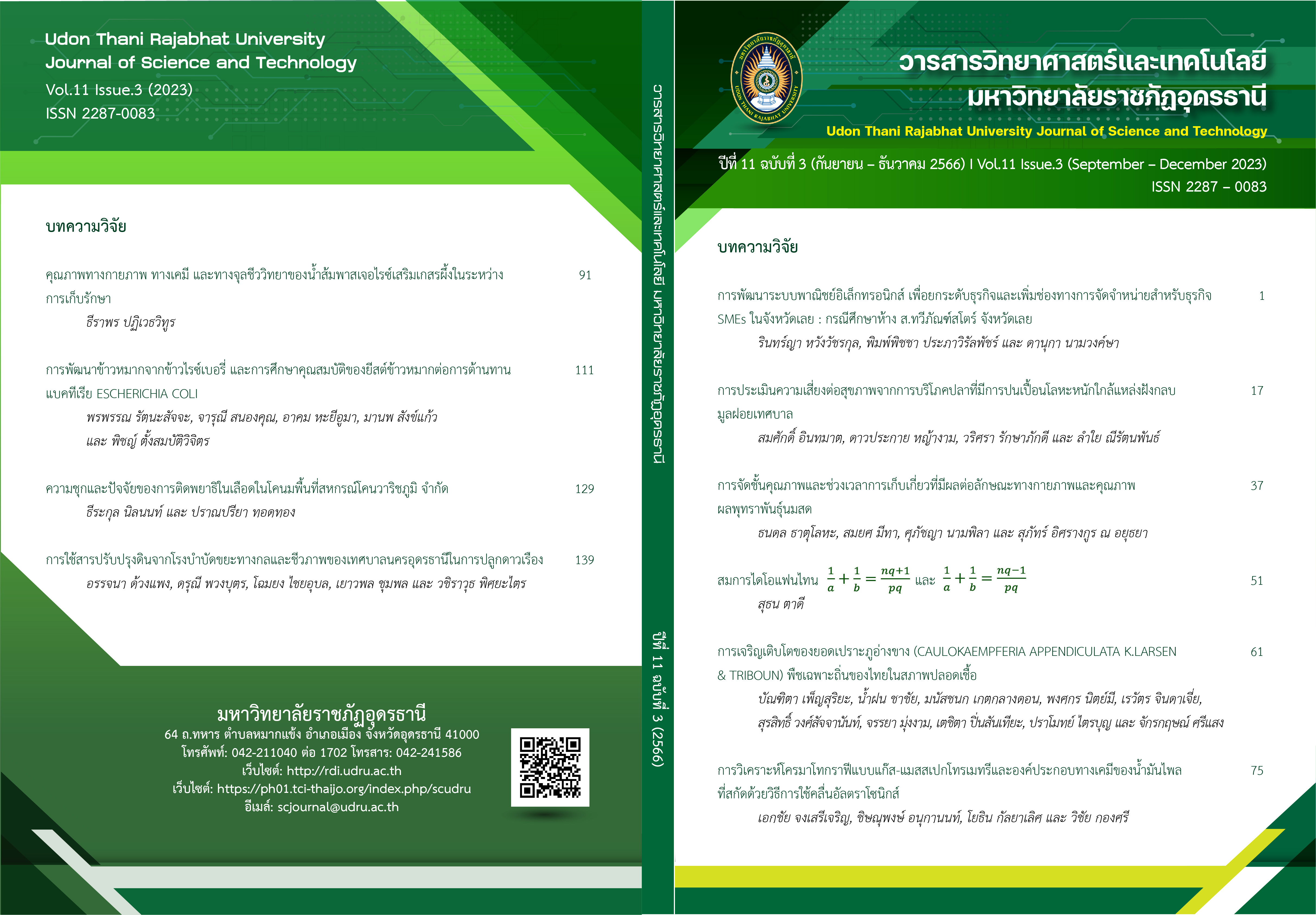THE USE OF SOIL STABILIZER FROM MECHANICAL AND BIOLOGICAL WASTE TREATMENT OF UDON THANI MUNICIPALITY FOR MARIGOLD CULTIVATION
Main Article Content
Abstract
The aim of this study was to investigate the impact of fermenting soil stabilizer by EM bacteria and the application rate of soil stabilizer on the growth and yield of marigold (F1), 'Devi'. The experimental design employed in this study involved the utilization of a factorial arrangement inside a Randomized Complete Block Design (RCBD) framework, specifically in the context of planting pots. Factor A refers to the process of fermenting soil stabilizer using effective microorganisms (EM), which is characterized by two distinct levels: the first process involves the fermentation of soil stabilizer with EM, whereas the second process pertains to the non-fermentation of soil stabilizer. Factor B represents the rate of application, which consists of two distinct levels. The first level involves the application of 200 g of soil stabilizer per 5 kg of mixed soil, while the second level involves the application of 400 g of soil stabilizer per 5 kg of mixed soil. The experimental group consists of a control treatment with a quantity of 5 kg of soil that has been mixed. The findings indicated that there were comparable characteristics observed in the soil stabilizers derived from the mechanical and biological waste treatment conducted by the Udon Thani Municipality, as well as those obtained from organic fertilizers. The composition of the soil stabilizer exhibited a significant concentration of organic matter and macronutrients, aligning with the organic fertilizer guidelines set by the Land Development Department. The utilization of soil stabilizer derived from mechanical and biological waste treatment in Udon Thani Municipality has the potential to be employed in the development of marigold plants. The marigold plant, when treated with a soil stabilizer, exhibited increased plant height, plant canopy, number of branches, number of flowers per plant, size of flowers, as well as average fresh and dry weight per flower, compared to the control treatment. The utilization of soil stabilizers in marigold production, without the need for fermentation, presents potential applications. The recommended treatment rate for optimal results is 200 g per 5 kg of mixed soil or approximately 2,000 kg per rai. This dosage has been found to effectively stimulate growth and enhance production in marigold plants.
Article Details
References
กรมควบคุมมลพิษ. (2547). คู่มือการทำปุ๋ยหมักจากขยะมูลฝอย. กระทรวงทรัพยากรธรรมชาติและสิ่งแวดล้อม. 16 หน้า.
กรมควบคุมมลพิษ. (2552). รายงานสถานการณ์มลพิษของประเทศไทยปี 2552. กระทรวงทรัพยากรธรรมชาติและสิ่งแวดล้อม. 4, 268 หน้า.
กรมพัฒนาที่ดิน. (ม.ป.ป.). มาตรฐานปุ๋ยอินทรีย์ (ปุ๋ยหมัก ปุ๋ยอินทรีย์คุณภาพสูง) ของกรมพัฒนาที่ดิน. กระทรวงเกษตรและสหกรณ์. สืบค้นเมื่อวันที่ 13 พฤศจิกายน 2566, จาก http://www1.ldd.go.th/ldd/Fertilizer/organic_Fertilizer.pdf.
กรีนเอิร์ธ. (ม.ป.ป.). สารปรับปรุงดิน. สืบค้นเมื่อวันที่ 13 พฤศจิกายน 2566, จาก https://www.greenearthinnovation.com.
ทวีพงศ์ สุวรรณโร, เอกวัฒน์ จันทรวงศ์ และ เรณู ดอกไม้หอม. (2545). การปลูกดาวเรือง. กรมส่งเสริมการเกษตร, กระทรวงเกษตรและสหกรณ์, กรุงเทพฯ. 19 หน้า.
ธงชัย มาลา. (2546). ปุ๋ยอินทรีย์และปุ๋ยชีวภาพ. ภาควิชาปฐพีวิทยา มหาวิทยาลัยเกษตรศาสตร์ วิทยาเขตกำแพงแสน.
นพมาศ นามแดง, เลิศพงษ์ มั่นวงศ์, ธิติมา มั่นวงศ์ และ อารีรัตน์ ลุนผา. (2565). อิทธิพลของปุ๋ยเคมี ปุ๋ยมูลม้า และปุ๋ยเคมีร่วมกับปุ๋ยมูลม้าต่อการเจริญเติบโตและผลผลิตดอกดาวเรือง. น. 54-64. ใน: การประชุมวิชาการระดับชาติ มอบ.วิจัย ครั้งที่ 16. 11-12 กรกฎาคม 2565. มหาวิทยาลัยอุบลราชธานี. สืบค้นเมื่อวันที่ 13 พฤศจิกายน 2566, จาก https://www.ubu.ac.th/web/files_up/00008f2022090117165337.pdf.
นวลปรางค์ ไชยตะขบ และ ธงชัย มาลา. (2548). ผลของปุ๋ยอินทรีย์จากวัสดุเหลือทิ้งของโรงงานผงชูรสที่มีต่อการเจริญเติบโตของดาวเรือง. น. 507-515. ใน: การประชุมทางวิชาการของมหาวิทยาลัยเกษตรศาสตร์ ครั้งที่ 43, สาขาพืช, วันที่ 1-4 กุมภาพันธ์ 2548, กรุงเทพฯ.
พัชรี สิริตระกูลศักดิ์, กาญแก้ว แซ่จ้าว, สกุลกานต์ สิมลา, มงคล วงศ์สวัสดิ์, และ สำเร็จ สีเครือดง. (2561). ผลของปุ๋ยหมักเติมอากาศต่อการเจริญเติบโตและผลผลิตของดาวเรือง. แก่นเกษตร, 46(ฉบับพิเศษ 1), 1211-1216.
ยงยุทธ โอสถสภา. (2543). ธาตุอาหารพืช. กรุงเทพฯ : สำนักพิมพ์มหาวิทยาลัยเกษตรศาสตร์.
รัตนชาติ ช่วยบุดดา และ บุศรินทร์ แสวงลาภ. (ม.ป.ป.). คู่มือการวิเคราะห์ดินทางเคมีเพื่อประเมินความอุดมสมบูรณ์ของดิน. เอกสารวิชาการสำนักวิทยาศาสตร์เพื่อการพัฒนาที่ดิน, กรมพัฒนาที่ดิน, กระทรวงเกษตรและสหกรณ์, กรุงเทพฯ. สืบค้นเมื่อวันที่ 13 พฤศจิกายน 2566, จาก https://e-library.ldd.go.th/library/Ebook/bib10134.pdf.
ศิราณี วงศ์กระจ่าง. (2560). ผลของการใช้ปุ๋ยหมักวัสดุอินทรีย์จากป่าพรุต่อการเจริญเติบโตของดาวเรือง. การเกษตรราชภัฏ, 16(1), 54-59.
สำนักงานสิ่งแวดล้อมภาคที่ 9 (อุดรธานี). (2565). รายงานผลการศึกษาการคัดแยกขยะมูลฝอย สถานที่กำจัดขยะเทศบาลนครอุดรธานี จังหวัดอุดรธานี. สืบค้นเมื่อวันที่ 13 พฤศจิกายน 2566, จาก https://www.mnre.go.th/reo09/th/information/ more/425.
อรรณพ คณาเจริญพงษ์, อรวรรณ ฉัตรสีรุ้ง, สุรเทพ เทพลิขิตกุล, ใจศิลป์ ก้อนใจ และ สมพร ชุนห์ลือชานนท์. (2546). ผลของวัสดุปลูกต่อการเติบโตและผลผลิตของดอกดาวเรือง. วารสารเกษตร, 19(2), 153-159.
Owen, W. G., Henry, J., and Whipker, B. E. (2019). Nutritional Monitoring: Marigolds (Tagetes erecta & T. patula). e-GRO Alert, Retrieved November 13, 2023 from https://www.e-gro.org/pdf/2017_641.pdf.

